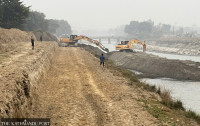National
Only five trucks have crossed the Tatopani border since its reopening
The Chinese side has imposed a host of restrictions, pointing to unresolved issues by the Nepal government, traders say
Anil Giri & Rajesh Khanal
Despite reopening the Tatopani-Khasa border point to much pomp and ceremony last month, only five trucks have entered Nepal since, a dismal showing for a trade point that was expected to revitalise bilateral trade with China.
Four trucks crossed into Nepal on the day the trade point opened, and since then, just one more truck carrying wool has arrived, according to Nepali traders.
Local traders who spoke to the Post pointed to a host of unresolved issues—numerous restrictions imposed by the Chinese, a lack of protocol for trade, the poor condition of connecting infrastructure, and a shortage of logistics—for the poor showing of what was once Nepal’s second largest trading point, with hundreds of trucks crossing over every day.
“The Chinese side has placed stern regulatory measures, even when goods are imported from Khasa,” said Hem Rawal, president of the Nepal Foreign Trade Association.
Nepali workers transferring goods from Chinese trucks are now expected to don Chinese uniforms, said local officials. Traders, too, say they have been barred from opening offices across the border with Nepali importers required to contact Chinese exporters on mobile phones or online to ascertain the time at which the goods are being shipped across the border.
However, government officials said that the border is functioning better than what’s been reported.
“At least four trucks are crossing the border every day,” said Kedar Bahadur Adhikari, secretary at the Ministry of Industry.
Nepali traders and local officials vehemently denied Adhikari’s assertions.
“Just a single business-related movement has taken place since the border point was reopened,” Sang Dorje Sherpa, chairperson of Phulping Katti ward of Bhotekoshi Rural Municipality, told the Post over the phone.
“On May 29, some ministers and leaders opened the border point. They went to Khasa, had lunch and returned with a token of love from the Chinese,” Sherpa said. “Since that day, one truck laden with wool arrived at the border point. That truck has been at the Tatopani dry port for the last 20 days due to a lack of documents.”
Tatopani-Khasa is one of the main land routes for trade with China. Upon a request from Nepal, the border point had been reopened and handed over on May 29, after being closed for four years following the 2015 earthquakes.
Along with the border point, the Chinese side had handed over the reconstructed Miteri Bridge, Kodari Highway and Tatopani dry port to Nepali authorities.
This time, however, the movement of goods and cargo is being strictly regulated by the Chinese while the Nepali government does not appear willing to comply with the new regulations.
Rabindra Shakya, vice-president of the Federation of Handicraft Associations of Nepal, said they’ve been unable to utilise the trade route as the government has failed to implement new regulations. Earlier, exporters required a recommendation letter from the Nepal Trans-Himalayan Border Commerce Association to send their goods across the border.
“But neither the association nor the government has enforced any clear policy to resume trade via the customs point,” said Shakya.
Both Nepali and Chinese authorities are rather flexible when traders use the Rasuwagadhi-Kerung route, according to Shakya. “The documentation process has been much simplified for those who wish to trade via this route,” he said.
It appears that the Chinese do not wish to make Tatopani-Khasa a major trade point, traders said.
“The construction of Kodari Highway is not on par with what the Chinese authorities had committed to and the dry port lacks the necessary equipment to load and unload shipped goods,” said a trader who is a member of the Nepal-China Chamber of Commerce and Industry. “This shows that China is unwilling to make the trade point fully operational.”




 9.12°C Kathmandu
9.12°C Kathmandu
















